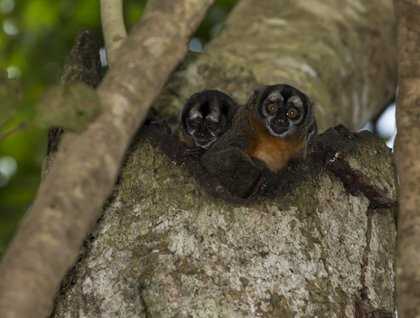Our first full day in the Ucayali River started a bit earlier than usual; we woke up before sunrise in order to get ready to board the skiffs just around the time when the first rays of the sun are beginning to illuminate the forest. Along the Ucayali, east of Belluda Caño, there is an area with an abundance of dead aguaje palm trees that provide excellent nesting sites to our target species this morning, the blue and yellow macaw. We searched along the shore and before long we were rewarded by the presence of several of those truly beautiful macaws; their long tails, white faces and amazing colors delighted everyone, and many pictures were taken. We also spotted numerous red-bellied macaws, a smaller species with green body, blue wings and a reddish lower belly. Their gregarious nature and complex social interactions were plainly evident, and we had a great time watching them perching together in big numbers, flying around and investigating the nesting potential of the palm trees.
After breakfast, we went back to the skiffs and continued our explorations in Belluda Caño; we watched many bird species, including white-eared jacamars, speckled chachalacas, roadside hawks and many more, and the mammals were represented this morning by monk saki monkeys and Spix’s night monkeys. Some of us went hiking into the varzea, which is the local name given to those areas of forest that get flooded every year and that remain underwater for 5-7 months. The diversity of trees in the varzea is actually bigger than in those areas that never get flooded, and today we learned about many of the adaptations that plants have developed in order to live there. It was an interesting feeling to walk in a place where dolphins will be swimming around in a few months!
In the early afternoon, we all headed into the Dorado River to explore from our skiffs. We found an abundance of aquatic birds like the capped heron, the anhinga and the Muscovy duck; we even discovered a group of the unique-looking hoatzin, a true icon of the Amazon basin.
Once it became dark enough, we turned on the spotlights and searched for caimans. A layer of cells at the back of their eyes that reflected our lights made it easy for us to locate them among the aquatic vegetation, and we were able to watch several spectacled caimans from a short but safe distance. Their ancient and wild appearance made the perfect ending for another beautiful day in the Peruvian Amazon!







